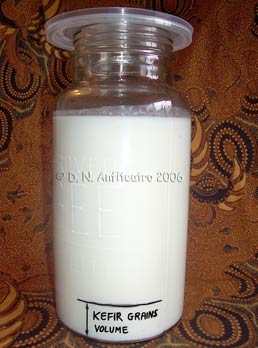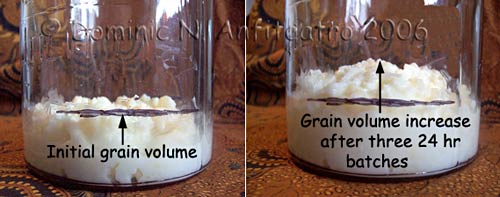The ratio of kefir grains to milk for preparing kefir, is quite flexible. But it can be determined by:
- Temperature – less milk may be used under cooler conditions, for the culture is less active.
- The activity of your kefir grains at any given point (culture activity of kefir grains can vary and is adjustable).
- The type of kefir you wish to produce (mild, slightly sour, extra sour. Lesser lactose with longer fermentation).
Culturing at temperatures ranging between 20°C to 28°C [64°F – 82°F], a grain-to-milk ratio by part or by volume of 1 : 10 and up to 1 : 60 is achievable. In cool temperatures below 19°C, ratios between 1 : 10 to 1 : 5 is usually achievable. Kefir prepared with less milk produces more viscosity with greater counts of yeast and acetic acid bacteria, less lactose and a sourer tasting kefir. On the other hand, using more milk produces less viscosity with greater counts of lactic acid bacteria, less with better grain growth.
Ratios of 1 : 3 and as high as 1 : 60 grain-to-milk by volume can be implemented in the home production of traditional kefir. Kefir grains are quite versatile and reasonably adaptable. NOTE It’s best not to exposed kefir grains to temperatures of 30°C to 35°C [86°F to 95°F] for periods longer than 12 hours.

In the photo, a grain-to-milk ratio of 1 : 7 by volume produces kefir with good flavour and consistency within 24 hours fermentation in a moderate temperature of about 22°C.
It’s a good idea to mark the outer wall of the fermenting container with a permanent marker, to indicate the level of kefir grains you put in the container, before adding any milk [as seen in photo on the left]. After preparing a few batches of kefir, check the volume of kefir grains after putting them back into the container after straining against the mark, and remove any grains that go above the mark.
Any removed kefir grains are your spare or excess grains, which you can use to prepare alternative types of kefir, such as non-dairy milk kefir, or kefirkraut. This removal of grains is done if you intend making the same amount of kefir each time. However, if you wish to increase production, then do not remove any grains from the batch yet, but instead, increase the amount of milk over a few batches as the grains increase in order to maintain the 1 : 7 ratio. When you are satisfied with the volume of kefir you are producing per batch, then make a new mark on the jar as before and commence removing amounts of grains as they increase past the mark after a few batches.
With a little experience you will soon learn that kefir grains can be encouraged to culture kefir to your liking pretty well with as much milk as you wish, as long as you remove grains regularly to prevent over crowding of grains in the milk. Otherwise you begin to starve the grains due to too much culture for the amount of milk. The outcome is that the kefir becomes very sour within 24 hours fermentation and the stress this causes due to subjecting the organisms to large amounts of organic acids begins to produce small kefir grains that do not grow as efficient as using a larger milk ratio.

This photo shows how much grain growth occurred over 3 consecutive 24 hours fermented batches of kefir.
The amount of grains in the jar on the right, that have increased over the mark, are removed. before adding any milk. I highly recommend and encourage folks to ingest their spare kefir grains, for they are very beneficial for health, and can provide a greater benefit to health than kefir for a fantastic probiotic HIT. Kefir grains them selves contain the specific beneficial Bifidobacterium psychraerophilum including other strains of Bifidobacterium, which are encapsulated in the grains and are not found in the kefir that the same grains produce. In order to reap any benefit of the Bifidum bacterium, one has to ingest the actual kefir grains.
How Full Can I Fill The Kefir-Making Jar?
Kefir fermenting jars for both milk kefir and water kefir are best not filled more than 2/3 to 3/4 full, especially if brewing in airtight jars when wanting to produce a fizzy kefir e.g. Due to yeast activity, kefir produces amounts of Carbon dioxide [CO2], which produces pressure in an airtight container. This has the potential to cause the lid of the jar to pop-off with force, or at worst the jar may explode. Even when fixing a loosely fitted lid on the jar so that any pressure can escape during the culture-cycle, filling the jar more than 2/3 may cause milk-kefir to overflow during the last part of the culture-cycle. This is because CO2 is retained within the kefir itself, increasing the overall volume of liquid in the jar, much like rising dough for bread making.
Also consider the possibility for the kefir to overflow after releasing an airtight lid. This occurs because dissolved CO2 in the media seeds on the tiny curds in the milk-kefir, producing pressure while releasing millions of gas bubbles, the process of which is similar to opening a cola drink bottle, which has been shaken before unscrewing the lid. Similar in this case, kefir will overflow out the jar, with the potential of causing a big mess.
